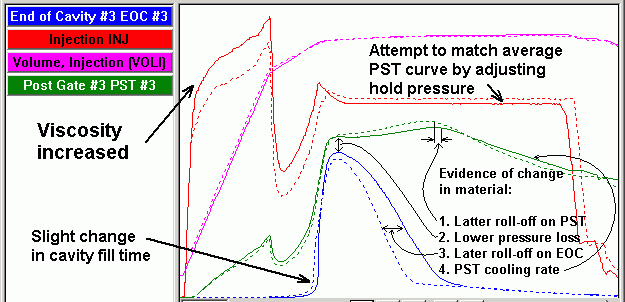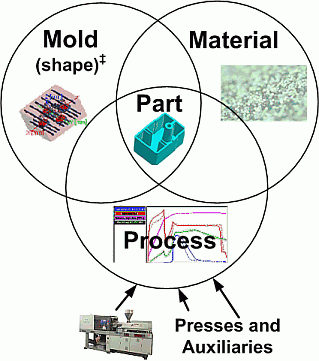Tip of the Day 160: When a matched template… doesn’t
… match.
Suppose you were molding a 7” diameter dish-shaped part out of glass filled polyester. It has a bunch of holes and bosses on it. You have pressure sensors at both post gate and end of cavity in all 4 cavities as well as a temperature sensor in each. You did the designed experiment, found the best process center and adjusted the steel to get the flatness within the specification of ± 0.010″.
One day some parts are returned from your customer. Sure enough they are out of specification for flatness. The process is running Decoupled 3, controlled velocity pack with cavity pressure control. The peak pressure is the same and the cavity temperature sensors show the same mold temperature.
You try to match the template by adjusting the hold pressure.

But you can only match the post gate and even that only approximately. And when you match one curve the other goes into out of the alarm band. Why?
Step back for a moment and consider what makes the part. Here is way of thinking inside the cavity that focuses on three fundamental aspects of creating the part.

The “process” is what is going on inside the part cavities (shapes): The “4” plastic variables. It is driven from the outside by various equipment: the press, coolant control, drying, hot runner temperatures, valve gate control etc.
In our story we did not change the mold (same press => no deflection) and tried to keep the process as constant as possible. What remains in the eternal molding triangle that can change?
Material.
If the material changes and the process and mold remain constant then the parts are likely to change. In this case the material was the same grade number but the supplier had changed the flame retardant. This apparently caused a change in nucleation or crystallization rate and hence changed the tendency of the part to warp.
Moral:
Decoupled III molding and template matching cannot control the whole process that makes the part †.
If the material changes significantly, especially in crystallization of semi-crystalline parts, you have a new and different material. You need to create a new process for that material using a new material in the eDART’s™ Job Setup. Then, after validating the parts, reset controls, templates and alarms for a new process to fit the new material.
Next Tip (# 161): How to Prove Material Change
Philosophical Phoot-notes
† Decoupled III provides significant improvement in pack pressure control when material chain lengths change the viscosity. In the lab we compare processes by throwing a viscosity shift into a D2 and D3 process and comparing the peak pressure results. This is to demonstrate the kind of material variation typical of changes in lot. It is possible that our students get the impression that D3 controls everything under any conditions. It does not.
Likewise, just matching a template will not make the same parts with a different material. Each different material compound has different packability, cooling and shrink rates for a given process. This includes both the molecular structure of the compound and the additives. Therefore matching the process template for a different material is likely to produce different parts.
Decoupled III and template matching is not a panacea. They are tools to reduce process variation (without human adjustment) to and detect changes. Some material changes are large enough that they require a new process.
‡ In some sense the mold as a whole could be considered an auxiliary. From the point of view of the plastic creating the part inside the cavity, all that it “knows” is the shape it is in and the plastic variables inside itself: Melt temperature, flow, pressure and cavity temperature. The water lines are an “auxiliary” designed to deliver the required process varaible “cooling rate” efficiently. Support pillars deliver a more constant cavity shape. The runners and gates deliver the plastic into the cavity. But the process acting on the material inside the shape makes the part, regardless of what is going on outside.